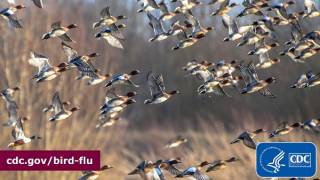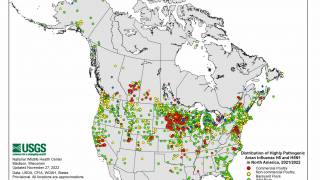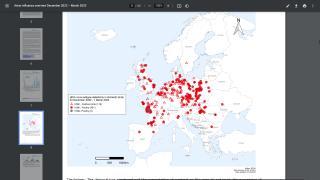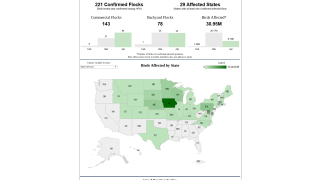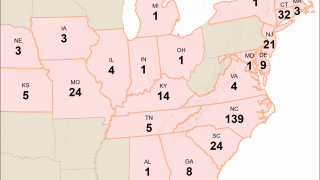U.S. CDC Prepares for Potential Bird Flu Outbreak

The U.S. Centers for Disease Control and Prevention (CDC) confirmed on November 1, 2021, an ongoing global monitoring program has recently identified three new human infections with avian influenza A(H5N6) virus (or “A(H5N6) bird flu”) in China.
Reported influenza A(H5N6) virus infections during 2021 have doubled the number of such cases detected since this virus was first found in people in 2014.
This increase raises concerns about the risk of additional human zoonotic infections and the pandemic potential of this virus.
Since 2014 when the first influenza A(H5N6) infection in a human was detected, fifty-one illnesses and 25 related deaths have been reported.
In 2021, twenty-four of the 25 cases identified were detected in China.
Most of the cases of influenza A(H5N6) reported in China during 2021 have had exposure to birds before illness onset.
The three newest infections occurred in adults who were reportedly hospitalized or in critical condition. In addition, there have been seven deaths (all in China) from influenza A(H5N6) this year.
In coordination with the World Health Organization Global Influenza Program, the CDC and global partners reviewed laboratory and epidemiologic data for influenza A(H5N6) viruses as well as existing H5 candidate vaccine viruses (CVVs) to assess their relatedness to current influenza A(H5N6) viruses during September 2021.
Based on current antigenic, genetic, and epidemiologic data, it was determined that previously recommended H5 CVVs are still expected to offer protection against influenza A(H5N6) viruses should vaccination be needed.
According to the CDC statement, it takes routine public health preparedness measures whenever a virus with zoonotic or pandemic potential is identified.
This action includes conducting a risk assessment and, as appropriate, preparing CVVs that could be used to rapidly make vaccines if needed.
The CDC conducted a formal risk assessment of highly pathogenic influenza A(H5N6) viruses in April 2016. It determined that these viruses posed a moderate risk in terms of their potential to cause a pandemic and the potential to cause moderate public health impact if they were to spread person-to-person.
The CDC says annual ‘flu shots’ are not effective against highly pathogenic influenza A(H5N6) viruses.
Since the first identification of human infections with influenza A(H5N6) viruses in 2014, multiple H5 CVVs have been developed to cover different antigenic groups of these viruses. In addition, a new risk assessment of influenza A(H5N6) is currently underway.
Analysis of influenza A(H5N6) viruses also shows that these viruses remain susceptible to influenza antiviral medications, such as neuraminidase inhibitors (oseltamivir, zanamivir, peramivir) and polymerase acidic (PA) protein inhibitor (baloxavir), meaning that treatment options would be available.
Avian influenza is a disease caused by infection with type A bird flu viruses.
These viruses occur naturally among wild aquatic birds worldwide and can infect domestic poultry and other bird and animal species. Bird flu viruses do not usually infect humans.
However, sporadic human infections with these viruses do occur.
This is concerning because of the possibility that bird flu viruses could change and gain the ability to spread quickly between people, with the potential to cause a flu pandemic; therefore, continued monitoring for human infections of bird flu and person-to-person spread is significant for public health.
Infected birds shed flu viruses in their saliva, mucous, and feces. Human infections with bird flu viruses can happen when enough virus gets into a person’s eyes, nose or mouth, or is inhaled. Influenza A(H5N6) was first detected in poultry in 2013 and has continued to spread among wild birds and poultry in many countries around the world.
While rare human infections with this and other bird flu viruses have occurred most often after unprotected contact with infected birds or contaminated environments, some infections have been identified where direct contact with infected birds or contaminated surfaces was not known to have occurred.
These infections serve as a reminder of the importance of following CDC’s recommended prevention measures for people to take when around birds, especially when traveling to countries where bird flu is endemic in poultry, and underscore the importance of ongoing pandemic preparedness measures.
According to the CDC, the risk to the U.S. public from these viruses is currently considered to be low. Still, each case of human infection with a bird flu virus should be fully investigated to be sure that such viruses are not spreading person-to-person and to limit further exposure of humans to infected animals or environments.
During the 2009 Bird Flu outbreak, the CDC estimated there were 60.8 million cases (range: 43.3-89.3 million), 274,304 hospitalizations (range: 195,086-402,719), and 12,469 deaths (range: 8868-18,306) in the United States due to the (H1N1)pdm09 virus, from April 12, 2009, to April 10, 2010.
Additionally, CDC estimated that 151,700-575,400 people worldwide died from (H1N1)pdm09 virus infection during the first year the virus circulated.
Globally, 80 percent of (H1N1)pdm09 virus-related deaths were estimated to have occurred in people younger than 65 years of age.
The CDC confirmed it continues to monitor the current situation in China and will provide updates as needed.
Additional Zoonotic influenza news is listed on this webpage.
PrecisionVaccinations publishes fact-checked research-based vaccine news.
Our Trust Standards: Medical Advisory Committee







